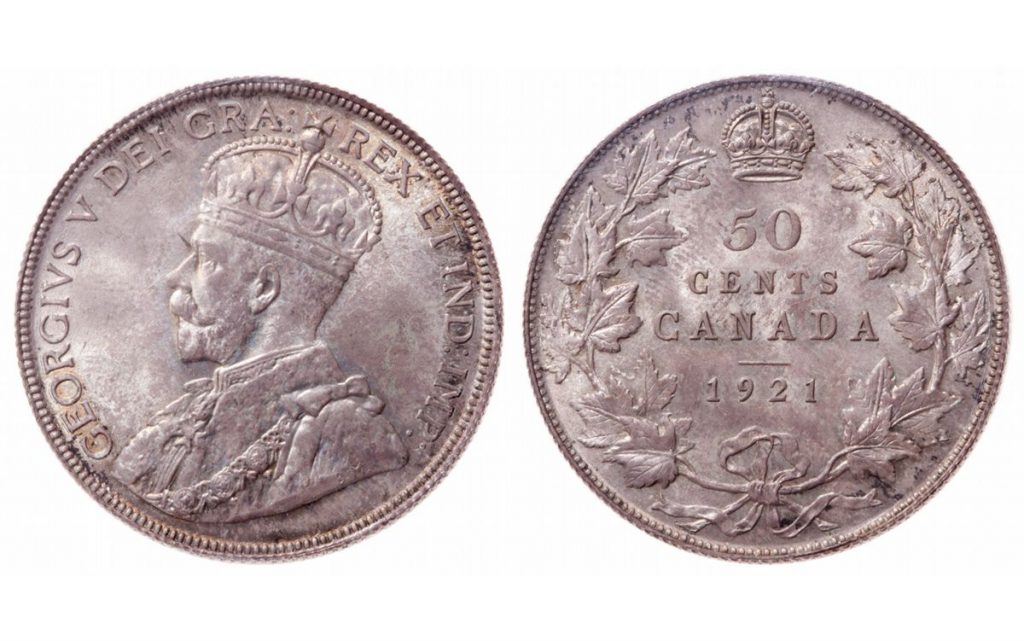On today’s date in 2015, a 1921 50-cent coin – the iconic rarity known as the “King of Canadian Coins” – hammered down for $220,000 during the Canadian Legacy Sale II.
Offered as Lot 1741 of the joint sale by Moore Numismatic Auctions, owned by the late Charles Moore, and Canadian Coin and Currency, the coin was graded Gem Uncirculated-65 by International Coin Certification Service (ICCS).
“It’s kind of the obvious stand-out piece of the collection, but I think what I like about the collection more than anything else is the fact that it’s consistently attractive and consistently high-quality,” auctioneer and Canadian Coin and Currency President Steven Bromberg told CCN in 2015.
“The consigner didn’t buy things if they weren’t attractive and absolutely solid, super high-grade. When you look through all the coins in this collection, it shows the eye for quality and eye for visual appearance for every one of the coins.”
Collected over the past two decades by a prominent Canadian businessman, the collection is one of the most significant in recent memory, Bromberg added. The collector maintained a strict set of standards, passing over inferior pieces in the search of perfection. To be added to the collection, a coin couldn’t just be one of the finest graded examples—it had to be well struck, completely problem-free and have superb eye-appeal.
‘THE STUFF OF NUMISMATIC LEGEND’
“The story of the 1921 50-cent piece is the stuff of numismatic legend, but like all legends that are worthy of the moniker, the tale of their origin is usually worth repeating,” reads the auction catalogue.
As the second decade of the 20th century was drawing to a close, the demand for half dollars – a denomination first introduced to Canada in 1870 – was waning.
In 1920, the 50-cent coin’s silver content was decreased to 80 per cent from its former sterling standard of 92.5 per cent. The following year, demand was so low the entire mintage of half dollars for 1921 (more than 200,000 pieces) was held in storage by the Royal Canadian Mint.
The coins remained there for eight years, until 1929, when the need for half dollars was sufficient enough to consider a re-release.
According to auctioneers, Mint Master John Honeyford Campbell was “reticent to release such a quantity of back-dated coins into the Canadian economy, for fear that the coins may be suspected as counterfeits.”
The stockpiled half dollars were subsequently melted and recoined into new 1929-dated 50-cent pieces. It’s believed only 75 of the 1921-dated coins survived the melting pot—some through the sale of Specimen sets and others through circulation strikes sold to visitors of the Mint.
“Here we present one of those fortunate few coins to have been saved from the furnaces of the Royal Canadian Mint, and of its few remaining brethren, this coin stands among the finest known to numismatics,” reads the 2015 auction catalogue, which adds ICCS certified only four examples of this rare piece in Mint State.
“This piece boasts a further numismatic lineage, having once been in the renowned collection of John J. Pittman, as attested by the pedigree-marker abrasion near the king’s eye.”
Of those four ICCS-graded examples, only one is finer than this (it’s graded as Mint State-66).
‘THE KING OF CANADIAN COINS’
Auctioneers boasted about the coin’s characteristics in the catalogue: “At first glance the toning of this historic coin evokes hues of lavender-grey, but a deeper look will reveal that this is overlaid on subtle shades of straw gold, with tiny flecks of charcoal grey nestled among the legend and reverse leaves. A scant tilt causes the deep original lustre to flash across the frosty surfaces, a striking compliment to the crisp, well-struck designs. Further examination with a loupe will yield little of note; a single blemish, not unlike a short brush-stroke, extends out from the king’s eye in the direction of the word ‘DEI’. The remainder of the fields remain astoundingly immaculate, perfectly preserved for over 90 years.
“While it may be inaccurate to state that the opportunity to purchase a 1921 50 cent of this caliber is a once-in-a-lifetime opportunity, the fact remains that hammer prices for these prize rarities do not remain static. The Belzberg coin, for example, originally sold for $78,200 in 2003, but subsequently realized $218,500 in 2010 for the self-same coin. This is an opportunity, therefore, that a savvy collector should not allow to slip by without serious pursuit.”
RECORD-BREAKING SALE
Altogether, the second part of the Canadian Legacy Sale offered 3,200 lots—many from the Victoria North Collection, which included a near-complete Canadian collection in Gem condition.
More than 700 lots were within the top 10 grading census or were the finest graded by various grading firms.
Although Bromberg sourced some of the Victoria North coins himself over the past two decades, seeing the entire collection together for the first time was an experience beyond his expectations.
Bromberg said after nearly three decades in the coin business, it’s “unusual for my jaw to drop in awe when viewing a collection. While the rarities are amazing, it is the consistent dazzling quality and eye-appeal of the collection that takes your breath away.”
Realizations in the four-session sale exceeded $4 million, which set a record for Canadian numismatic auctions.

